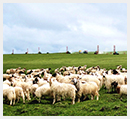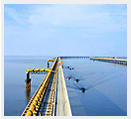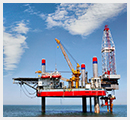Wetland Protection
Wetlands play a unique environmental role, helping to maintain an ecological balance, while also protecting biological diversity and rare species. Wetlands are vital in the conservation of water bodies and the prevention of flooding, droughts, soil erosion and the loss of groundwater.
China has some of the planet's richest wetland resources, with its wetland coverage being the highest in Asia and fourth in the world. The Zhalong Wetland, located to the southeast of the city of Daqing in China's northeastern Heilongjiang Province, has been listed as one of the world's major wetlands by the Ramsar Convention on Wetlands, which was signed in Ramsar, Iran, in 1971 and which came into force in China in 1992. The Daqing Oilfield covers two-thirds of the wetland, which boasts 76 species of birds including the red-crowned crane, swan and red-beaked gull, as well as 45 species of fish and diverse flora.
The Shuangtai Estuary is one of the world's best-protected wetlands. It is home to a total of 409 species of wild animals, including 257 kinds of birds. Black-beaked gulls, the world's rarest water bird, and red-crowned cranes, one of China's most important protected birds, also dwell in the wetland.
The Liaohe Oilfield's tidal and shallow water operations are located in the Shuangtai Estuary Wetland Reserve, with thousands of oil wells in the widest reed marshes. In August 2006, four rainstorms hit the area, and oil wells were submerged. Liaohe Oilfield immediately launched the Anti-flood Environmental Protection Plan, ensuring that there was no single incidence of spillage by any of the oil wells in the reed marshes.
Thirty years ago, the total area of reed marsh in the Liaohe Delta was less than 80,000 hectares. With the joint efforts of Liaohe Oilfield and the local government, the total area of the marsh has now reached over 100,000 hectares, making it the world's largest reed marsh. Under this marsh, there lies the "world's heaviest" Liaohe heavy oil and super-heavy oil. As a result of thirty years of hard work, this area has been built into a heavy oil production base with an annual capacity of millions of tons. Heavy oil accounts for 60% of the total production of the Liaohe Oilfield, making it China's biggest heavy oil and super-heavy oil production base.
In terms of engineering construction, Liaohe Oilfield strictly complies with environmental laws and regulations and fully meets all targets related to wastewater drainage, oil sludge treatment, well-drilling waste treatment, and waste mud treatment. In 2006, the company invested 20 million RMB in the testing and reconstruction of an oil, gas and water pipeline system in order to prevent potential hazards. The increased investment in environmental protection guarantees the healthy development of this great reed marsh.
Our biodegradation project won high appraisal from DNV, and an environmental protection award from the Sudanese Ministry of Energy and Mining, and has become a model project of the ministry.


- CNPC Actively Participates in OGCI Activities to Promote Carbon Emissions Reduction in the Industry
- Protection of Marine Ecology in the Libra Project, Brazil
- Recycling of waste in Niger
- 10 Large-scale Carbon Sink Bases were Established in Changqing Oilfield
- Strengthen Pollution Control and Restoration of Soil and Ground Water
- Working with OGCI in 2018
- Strengthen Pollution Control and Restoration of Soil and Ground Water
- Ecology Before Economy
- Tianjin Climate Exchange
- OGCI Actions
- Supporting the Paris Agreement
- Wetland protection in North Azadegan project gains recognition from the host country
- Green drilling to protect the environment
- West-East Gas Pipeline Project Delivering Clean Energy
- Soil Restoration by Using Microorganism Repair Technology
- Protecting the Tropical Rainforest in Ecuador
- Building Carbon Emission Reduction Base in Zhongwei City
- Planting Trees to Foster a Green Environment
- Gas pipeline keeps away from populus euphraticas
- Restoring Marine Environment and Fishery Resources
- Protecting wetland to create a better habitat for migrant birds
- Desulfurizing FCC regenerator flue gas to reduce emissions
- Comprehensive Utilization of Coke Oven Gas in Wuhai, Inner Mongolia
- Successful Trial Flight of Aviation Biofue
- Environmentally Friendly Construction to Protect Wild Animals
- Green Oilfield in Bohai Bay
- Ecological restoration by the Western Pipeline project
- Green Carbon Pool: CO2 Emission Control through Forestation
- Nitrous Oxide Emission Reduction Project of Liaoyang Petrochemical
- Improving Environment in Sudan
- Protecting Euphrates Poplars in the Desert
- Protecting Ecuadorian Tropical Rainforests in Operation Sites
- Seawater, Recycled Water, and Fresh Water
- Environmental Protection in the Development and Construction of Shixi Oilfield
- Wetland Protection
- Green Corridor in the Desert
- Environmental Protection in the West-East Gas Pipeline Project









